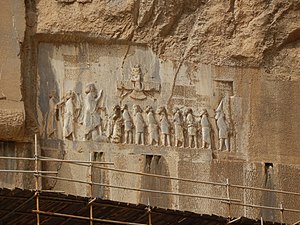
Back Behistoen-inskripsie Afrikaans نقش بيستون Arabic Bisütun kitabəsi Azerbaijani Бехістунскі надпіс Byelorussian Бехистунски надпис Bulgarian বেহিস্তুন শিলালিপি Bengali/Bangla Inscripció de Behistun Catalan وێنەبەردینەی بێستوون CKB Behistunský nápis Czech Bisutun-inskriptionerne Danish
| UNESCO World Heritage Site | |
|---|---|
 | |
| Location | Mount Behistun, Kermanshah Province, Iran |
| Criteria | Cultural: ii, iii |
| Reference | 1222 |
| Inscription | 2006 (30th Session) |
| Area | 187 ha |
| Buffer zone | 361 ha |
| Coordinates | 34°23′26″N 47°26′9″E / 34.39056°N 47.43583°E |
The Behistun Inscription (also Bisotun, Bisitun or Bisutun; Persian: بیستون, Old Persian: Bagastana, meaning "the place of god") is a multilingual Achaemenid royal inscription and large rock relief on a cliff at Mount Behistun in the Kermanshah Province of Iran, near the city of Kermanshah in western Iran, established by Darius the Great (r. 522–486 BC).[1] It was important to the decipherment of cuneiform, as it is the longest known trilingual cuneiform inscription, written in Old Persian, Elamite, and Babylonian (a variety of Akkadian).[2]
Authored by Darius the Great sometime between his coronation as king of the Persian Empire in the summer of 522 BC and his death in autumn of 486 BC, the inscription begins with a brief autobiography of Darius, including his ancestry and lineage. Later in the inscription, Darius provides a lengthy sequence of events following the death of Cambyses II in which he fought nineteen battles in a period of one year (ending in December 521 BC) to put down multiple rebellions throughout the Persian Empire. The inscription states in detail that the rebellions were orchestrated by several impostors and their co-conspirators in various cities throughout the empire, each of whom falsely proclaimed himself king during the upheaval following Cambyses II's death. Darius the Great proclaimed himself victorious in all battles during the period of upheaval, attributing his success to the "grace of Ahura Mazda".
The inscription is approximately 15 m (49 ft) high by 25 m (82 ft) wide and 100 m (330 ft) up a limestone cliff from an ancient road connecting the capitals of Babylonia and Media (Babylon and Ecbatana, respectively). The Old Persian text contains 414 lines in five columns; the Elamite text includes 260 lines in eight columns, and the Babylonian text is in 112 lines.[3][4] A copy of the text in Aramaic, written during the reign of Darius II, was found in Egypt.[5] The inscription was illustrated by a life-sized bas-relief of Darius I, the Great, holding a bow as a sign of kingship, with his left foot on the chest of a figure lying supine before him. The supine figure is reputed to be the pretender Gaumata. Darius is attended to the left by two servants, and nine one-meter figures stand to the right, with hands tied and rope around their necks, representing conquered peoples. A Faravahar floats above, giving its blessing to the king. One figure appears to have been added after the others were completed, as was Darius's beard, which is a separate block of stone attached with iron pins and lead.
- ^ "The Arya in Iran".
- ^ "Behistun Inscription is a cuneiform text in three ancient languages."Bramwell, Neil D. (1932). Ancient Persia. NJ Berkeley Heights. p. 6. ISBN 978-0-7660-5251-2.
- ^ Tavernier, Jan (2021). "A list of the Achaemenid Royal Inscriptions by language". Phoenix (in French). 67 (2): 1–4. ISSN 0031-8329. Retrieved 2023-03-25.
The rock inscription itself contains no less than 414 lines of Old Persian, 112 lines of Babylonian and 260 lines of Elamite (in an older and a younger version).
- ^ "The Bīsitūn Inscription [CDLI Wiki]". cdli.ox.ac.uk. 2015-09-06. Archived from the original on 2023-03-25. Retrieved 2023-03-25.
This tri-lingual inscription has 414 lines in Old Persian cuneiform, 260 in Elamite cuneiform, and 112 in Akkadian cuneiform (Bae: 2008)
- ^ Tavernier, Jan, "An Achaemenid Royal Inscription: The Text of Paragraph 13 of the Aramaic Version of the Bisitun Inscription", Journal of Near Eastern Studies, vol. 60, no. 3, pp. 161–76, 2001

